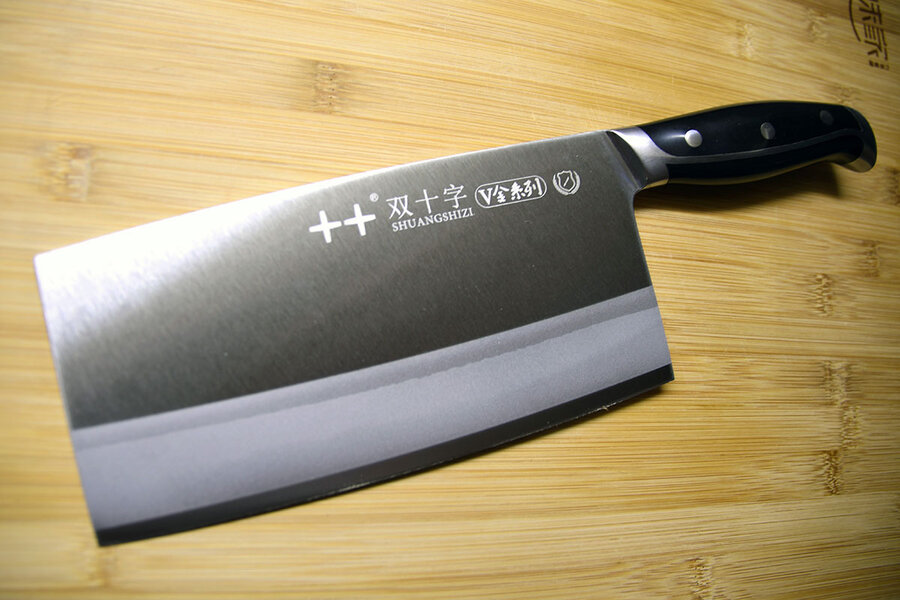Slice of life: A reporter's search for knives in Beijing
Loading...
| Beijing
The caidao, or “vegetable knife,” is not just any knife. In Chinese cooking, it’s really the only knife. Although the cleaver-like tool looks unwieldy, it expertly handles delicate work like peeling ginger, crushing garlic, or scooping up food to toss in the wok. A caidao convert since living in China after college, I am convinced that other knives, quite literally, can’t cut it. So two days after landing back in Beijing, I am wandering through a bustling supermarket like a child in a candy shop, snatching up supplies I need to cook favorite dishes, including a knife. But the tool’s mere mention brings an unexpectedly blunt response. “What do you want to do, kill someone?!” a uniformed store clerk replies. In recent years, the Communist Party has cracked down on knives in response to some high-profile knife attacks and stabbings. Procuring one, I’m told, involves registering your name and ID number, along with the model and quantity of knives bought – and you can’t buy them just anywhere. So I head into the throngs of holiday shoppers, as the Chinese kick off Golden Week. Knowing millions of chefs here rely on their caidao, I decide I must track one down.
Why We Wrote This
As a young reporter in Beijing in the 1980s, Ann Scott Tyson became a fan of the caidao, a hefty Chinese knife. Today, with knives tightly regulated, her search for a caidao became a quest across the city.
Two days after landing back in China, I am wandering through a bustling Beijing supermarket like a child in a candy shop, snatching up the spices and fresh ingredients I need to cook favorite Chinese dishes.
The mood in the market is equally festive, as it is the eve of China’s Oct. 1 National Day and the “Golden Week” holiday – a rare official seven-day respite from work. Fellow shoppers go out of their way to help this Mandarin-speaking American find the silkiest variety of tofu, the fragrant (but not too costly) rice, and the spiciest bean paste. Having lived in Beijing and Hong Kong as a young reporter, I’d learned to love homestyle Chinese food.
The last thing I need for the meal is a Chinese chef’s knife, or caidao – the cleaver-like tool ubiquitous in Chinese kitchens. But the mere mention of the knife brings an unexpectedly blunt response from the store’s uniformed clerk.
Why We Wrote This
As a young reporter in Beijing in the 1980s, Ann Scott Tyson became a fan of the caidao, a hefty Chinese knife. Today, with knives tightly regulated, her search for a caidao became a quest across the city.
“No, no knives!” she exclaims.
Surprised, I ask again, only to be directed to an aisle with a few small fruit knives. This must be a misunderstanding.
“Sorry, but I’d like to buy a caidao,” I persist, drawing a sketch of the large, rectangular chopper.
“What do you want to do, kill someone?!” the clerk replies. “Kitchen knives are a restricted product!”
My dinner plan thwarted, I pay for my groceries and leave. Walking back to my apartment, I think about how differently governments across the world regulate weapons, or could-be weapons, from the free-wheeling gun laws of the United States to the strict controls of Japan. Then there are places like Iraq, where as a war correspondent in the aughts I covered a ceasefire accord between rival Sunni and Shiite religious sects that imposed a limit of 10 AK-47s per mosque.
For its part, China’s Communist Party has largely prohibited civilian gun ownership since taking power in 1949, and in recent years has cracked down on knives in response to some high-profile knife attacks and stabbings.
Still, kitchen knives? What’s a Chinese homemaker to do?
The caidao is not just any knife – in Chinese cooking it’s really the only knife. Known as the “secret weapon” of Chinese chefs, the caidao, despite its crude appearance, is not a butchering tool but a highly versatile all-around knife. Its weight makes slicing, chopping, and mincing easy and fast. Although it looks unwieldy, the caidao, which translates as “vegetable knife,” expertly handles delicate work such as peeling ginger. Its large flat side is useful for crushing garlic to loosen the skin and scooping up food to toss in the wok.
The caidao is especially vital in a country where chopsticks have been the main eating utensil for 2,000 years, since the Han Dynasty, requiring food to be cut up in the kitchen and served in bite-sized pieces. (Confucius was said to scorn the presence of knives at the table.)
A caidao convert since living here after college, I am convinced that other knives, quite literally, can’t cut it. Knowing that millions of Chinese feel the same way, I decide I must track one down.
The next day, National Day, I join a throng of Chinese stepping into a subway station to head to Wangfujing Street – Beijing’s main shopping thoroughfare. After sliding my purse through the mandatory metal detector, I pass a photo display of items riders are forbidden to carry on the metro. Prominent in the top row is a caidao. If my mission succeeds, I will not be returning by subway.
Wangfujing is jammed with holiday shoppers and tourists from other provinces, many of them carrying little red Chinese flags. Some munch roasted ears of corn. Others snap photos of giant flower arrangements, reminiscent of parade floats, set up by the government as holiday displays at major intersections. Police wearing sunglasses and black uniforms patrol in formation, toting riot shields.
I enter the Beijing Mall, a vast, seven-story complex, and approach the information desk.
“Excuse me, where can I buy a caidao?” I ask a young woman wearing a white blouse and kerchief.
“We don’t sell any knives here,” she says, not missing a beat.
“Could you tell me where I can find one?” I ask.
“I’m not clear about that,” she replies. Nothing, not even a lead.
Further up the street at a Chinese arts and crafts store, my query about knives elicits only a nervous burst of laughter from a male clerk.
My next stop is the Beijing Department Store, a longtime fixture on Wangfujing. In the early post-Mao era, grumpy clerks in padded jackets sold basic Chinese products such as cotton undershirts and bedding. But today it’s more like Macy’s, filled with the scent of foreign perfume as well as designer fashions, watches, and other luxury goods. On the fifth floor, amid Italian pots and French casseroles, I find a German knife store. There, in a locked cabinet, is an expensive German version of a caidao.
Surely, I think, few Chinese would buy such a pricey foreign knife. But when I ask the clerk where I can obtain an ordinary Chinese caidao, she pushes back.
“No Chinese supermarkets sell these knives. They are restricted. You have to buy them in special stores and register with your identity card,” she reveals, pulling out a brown paper ledger from the Beijing Municipal Public Security Bureau.
The ledger records the names and ID card numbers of purchasers, along with the date, model numbers, and quantity of knives bought. In my case, I would be required to submit my passport. I decide to hold out for an authentic Chinese knife.
Just then, a bystander, having overheard the conversation, steps in. Pulling out a map, he directs me to a shop about a mile away, and I trudge off again across town.
Finally, I arrive at the address and find a small, one-story knife and scissors shop, with a traditional red-lattice window and a sign with gold characters. Stepping inside, I find a display case full of affordable caidao made by one of Beijing’s oldest knife-makers, with origins 200 years ago in the Qing Dynasty.
A low-key attendant explains the knifemaker adds an extra middle layer of steel to keep the caidao sharp. “These will last 20 or 30 years,” she says. I pick out one of the larger Shuangshizi (Double Cross) brand models, 12 inches long with a 7-by-4-inch blade. Described on the box as “mighty and sharp,” the weight feels just right in my hand. A bit carried away, I buy three.
Posted on the wall are official regulations requiring makers of guns, knives, explosives, and other dangerous goods to track their products, and a police announcement offering rewards to citizens who report suspicious persons and help prevent attacks.
Still, after I pay for the knives, the saleswoman says I don’t have to register.
“We only register people when there’s a big meeting going on in Beijing,” she says with a smile. Although it is National Day, with China’s top leaders appearing in ceremonies in Tiananmen Square, I don’t question her decision. With the knives in hand and the scent of Chinese stir-fry in the air, I smile and head home, on foot.








